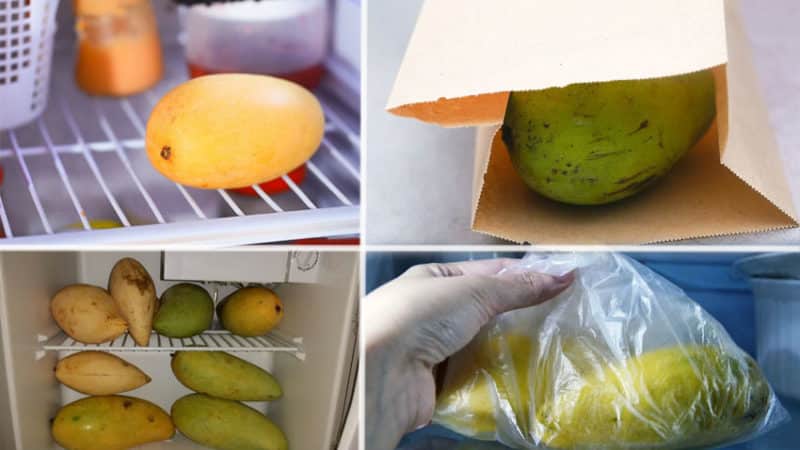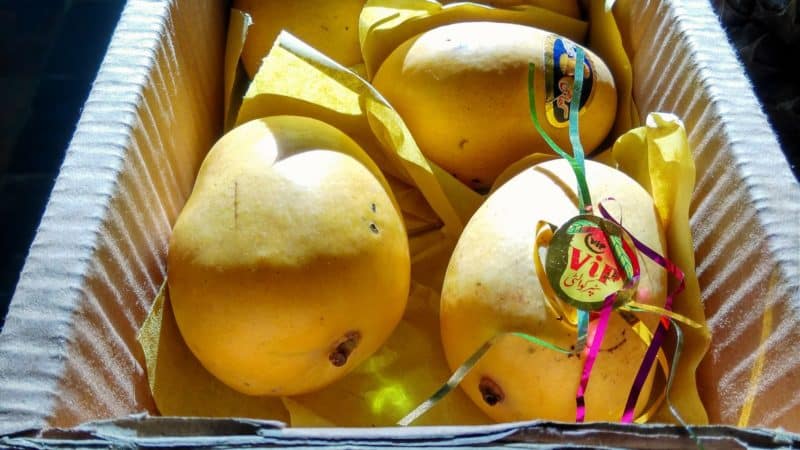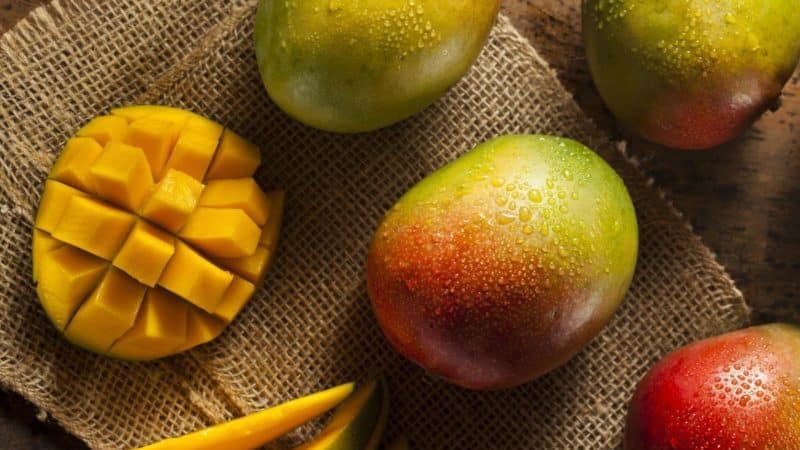How to store mangoes at home so they don't spoil
Mango is a delicious exotic fruit that is sold in many supermarkets. The fruits are delivered unripe in order to be preserved during transportation. We'll tell you later how to store mangoes at home so they don't spoil and help unripe fruit ripen.
How and where to store mangoes at home so that they ripen
If your plans do not include eating mangoes right away, it is better to buy unripe hard fruits and create conditions at home for them to ripen.
How and what to wrap

Using regular newspaper, a sheet of paper or a clean paper bag, unripe fruit can be made ripe and sweet. The fruit is wrapped in paper and left to lie at room temperature. It will become softer in a couple of days. Ripening occurs due to the release of ethylene.
It is important not to wrap the mango paper too tightly to prevent mold from forming. Periodically check the ripeness of the fruitso that it does not overripe and spoil. Ripening is judged by the appearance of a pleasant sweet smell.
Reference. You can put an apple or banana in a paper bag with an exotic fruit. They increase ethylene production and ripening occurs faster.
At what temperature
If the mango is unripe, do not immediately put it in the refrigerator - at low temperatures the fruit will definitely not ripen. And if you keep an unripe fruit in the refrigerator for a long time, it will completely spoil.Even if the fruit becomes ripe in appearance, its taste will not be sweet, since at low temperatures the process of sugar formation in the fruit slows down.
In order for the hard, unripe fruit to become soft and ripe, it is left at room temperature +18...+23°C.
How to determine ripeness

The ripeness of the fruit is determined by several criteria:
- The smell of ripe fruit is very strong - sweet, honey.
- Elasticity. Squeeze the mango lightly: if the fruit is ripe, you will feel the flesh give in slightly when pressed.
- Uniformity of color. A red spot does not always indicate ripeness.
- Dark spots on the peel do not mean the fruit has gone bad. It may contain large amounts of sucrose.
If there are not too many spots on the peel, the aroma is pleasant, and the fruit itself is tight and smooth, it is worth purchasing.
How to preserve ripe mangoes at home
Depending on the ripeness and when the fruit is going to be consumed, several storage options are used.
At room temperature
Ripe fruit cannot be stored at room temperature - in such conditions it will quickly rot. This fruit is eaten immediately or stored in the refrigerator. As an option, make it into a fruit salad with kiwi and banana or add it to a milkshake.
In a refrigerator

How long does a mango last in the refrigerator? The ripe fruit is placed in the refrigerator on the middle shelf at a temperature of +3...+5°C. He will stay there for 5-7 days. At the same time, they carefully monitor so that the fruit does not begin to deteriorate.
Attention! Do not store mangoes in the refrigerator in plastic bags, as they need air access.
The mango can be placed on a plate or wrapped in a paper bag. In a special compartment for storing fruit in the refrigerator, it will last up to 10 days.
If the mango is cut and not eaten, it is placed in the refrigerator, first wrapped in cling film. In this form it is stored for no more than a day.
In the freezer
Frozen mangoes can be stored for several months.
Important! Before freezing, the fruit is peeled and pitted.
The fruit is cut into pieces and placed on a plate or board and frozen. Place the frozen fruit in a bag or container with a tight-fitting lid and leave it in the freezer.
At a temperature of -24...-18°C, mango can be stored for up to 3 months. The aroma and taste of the fruit after defrosting will be as bright as that of a fresh fruit.
How to preserve mangoes longer

There are several ways to help preserve the taste and aroma of your favorite fruit for a longer period. The same storage and preservation methods are suitable for mangoes as for apples, pears, plums and cherries.
Dried slices
The fruit is cut into pieces and dried in a dryer or in the sun, after covering with gauze. If you soak the pieces in syrup before drying, you will get delicious candied fruits. Dried slices are stored in the refrigerator in a closed container for 6 months.
Jam or jam
The simplest jam recipe is to sprinkle chopped fruit with sugar, put on low heat and cook for 20 minutes. Other fruits or spices are added for variety. The jam is stored at room temperature for 1 year.
Paste
The fruit is boiled until thick, poured onto parchment and allowed to dry naturally or in a dryer. After this, store in the refrigerator for 2-3 weeks.
Confiture
The diced fruit is mixed with sugar and left for a short time until the juice appears. Then the mixture is put on fire, brought to a boil, a gelling agent is added and boiled for another 3 minutes. After cooling, the mixture is punched with a blender. The confiture is ready.It can be stored for 1 year at room temperature.
Marmalade
The chopped mango is mixed with sugar and left. When the juice is released, the mixture is put on fire and boiled to a puree. Then rub through a sieve and add agar-agar.
The marmalade is left to harden in individual molds or in a frame, and then cut into slices. Store it in the refrigerator for up to 7 days.
In sugar syrup
A thick syrup is made from water and sugar. Mango slices are dipped in syrup and boiled for 5-10 minutes. Wedges in syrup can be stored in the refrigerator for a week.
In salt water
For salads, mango is marinated in brine until it loses its color. In this form it can be stored for a week in the refrigerator.
Differences in storing mangoes from Thailand and Vietnam

The main countries supplying exotic fruits to the Russian market are Vietnam and Thailand.
Vietnamese mangoes, Unlike Thai ones, they are not so sweet. The consistency is delicate and thick, without coarse fibers. Often there are fruits that are sweet, but with hard fibers, or vice versa, with pleasant pulp, but not very sweet.
In Thailand There are many more varieties of mango, their taste is richer and sweeter. The pulp is tender, without fibers.
Despite the fact that fruits from these countries differ in taste, color and shape, they do not differ in storage. The methods listed above are suitable for both Thai and Vietnamese mangoes.
This is interesting:
What is chard, how to eat it correctly and how it can be useful.
What is a fig and what is remarkable about the fig tree.
Raspberries: beneficial properties of the berry and possible harm.
Conclusion
To select a tasty mango, the fruits are examined for firmness and sweetness of aroma. You may also find unripe fruit in stores.They help him reach maturity at home and then eat him. You can put it in the freezer or save it in the form of jam, confiture, or dried pieces.